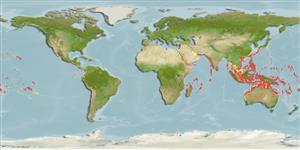Hexacorallia |
Scleractinia |
Pocilloporidae
Environment: milieu / climate zone / ระดับความลึก / distribution range
นิเวศวิทยา
เกี่ยวกับหินโสโครก; ระดับความลึก 0 - 54 m (อ้างอิง 269). Tropical; 36°N - 31°S, 32°E - 10°E (อ้างอิง 847)
Indo-Pacific.
Length at first maturity / ขนาด / Weight / Age
วัยเจริญพันธุ์: Lm ? range ? - ? cm Max length : 30.0 cm WD เพศผู้/กระเทย; (อ้างอิง 269)
Colonies irregularly branching (ramose), less than 30 cm in diameter, covered with verrucae; corallites plocoid, about 0.1 cm across, found both on verrucae and in between. Stout branches usually more than 1 cm in diameter, but varies with exposure to water movement and depth. Colonies growing in shallow water or exposed to wave action tend to have thick sturdy branches while those from deep calm waters tend to have thinner branches. Color is mottled light brown in life and skeleton usually has reddish brown patches after cleaning (Ref. 269).
Maximum depth from Ref. 98471. It is found from fore-reefs (Ref. 87903) to protected fringing reefs and coral communities living on rocky substrates (Ref. 98471). Colonies growing in shallow water or exposed to wave action have thick sturdy branches while those from deep calm waters have thinner branches (Ref. 269).
Life cycle and mating behavior
วัยเจริญพันธุ์ | การสืบพันธุ์ | การวางไข่ | Eggs | ความดกของไข่ | Larvae
Hermaphroditic (Ref. 113708). Mature gametes are shed into the coelenteron and spawned through the mouth. Life cycle: The zygote develops into a planktonic planula larva. Metamorphosis begins with early morphogenesis of tentacles, septa and pharynx before larval settlement on the aboral end (Ref. 833).
Hodgson, G. 1998 Corals. p. 101-122. In Carpenter, K.E. and V.H. Niem (eds) FAO species identifidication guide for fishery purposes. The living marine resources of the Western Central Pacific. Vol. 1. Seaweeds, coral, bivalves and gastropods. FAO Rome. (อ้างอิง 269)
IUCN Red List Status
(อ้างอิง 130435: Version 2025-1)
CITES status (อ้างอิง 108899)
CMS (อ้างอิง 116361)
Not Evaluated
Threat to humans
Human uses
| FishSource |
เครื่องมือ
ข้อมูลเพิ่มเติม
นิเวศวิทยาเขตร้อนFood items (preys)องค์ประอบของอาหารการบริโภคอาหารผู้ล่า Life cycleการสืบพันธุ์วัยเจริญพันธุ์ความดกของไข่การวางไข่EggsEgg developmentLarvae Human RelatedStamps, coins, misc.
แหล่งที่มาจากอินเตอร์เน็ต
Estimates based on models
Preferred temperature
(Ref.
115969): 24.8 - 29, mean 27.9 (based on 1106 cells).
Fishing Vulnerability
Low vulnerability (20 of 100).
Price category
Unknown.
